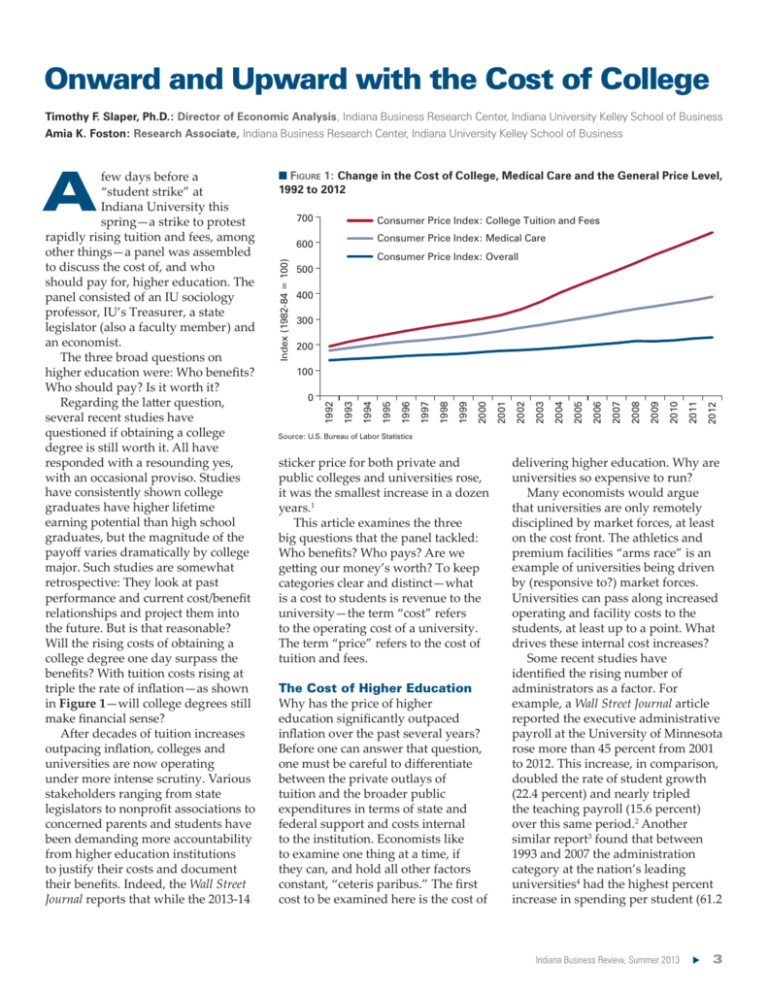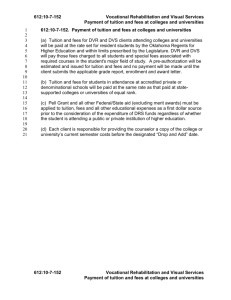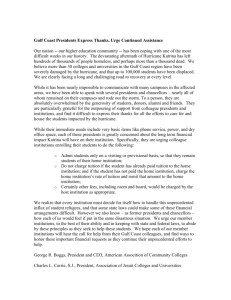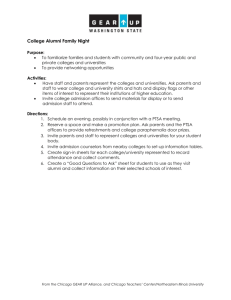Onward and Upward with the Cost of College
advertisement

Onward and Upward with the Cost of College Timothy F. Slaper, Ph.D.: Director of Economic Analysis, Indiana Business Research Center, Indiana University Kelley School of Business Amia K. Foston: Research Associate, Indiana Business Research Center, Indiana University Kelley School of Business FIGURE 1: Change in the Cost of College, Medical Care and the General Price Level, 1992 to 2012 700 Consumer Price Index: College Tuition and Fees Consumer Price Index: Medical Care 600 Index (1982-84 = 100) Consumer Price Index: Overall 500 400 300 200 2012 2011 2010 2009 2008 2007 2006 2005 2004 2003 2002 2001 2000 1999 1998 1997 1996 1995 1994 0 1993 100 1992 A few days before a “student strike” at Indiana University this spring—a strike to protest rapidly rising tuition and fees, among other things—a panel was assembled to discuss the cost of, and who should pay for, higher education. The panel consisted of an IU sociology ǰȱȂȱǰȱȱȱ legislator (also a faculty member) and an economist. The three broad questions on ȱȱ DZȱȱęǵȱ ȱȱ¢ǵȱȱȱ ȱǵȱ ȱȱĴȱǰȱ several recent studies have questioned if obtaining a college degree is still worth it. All have responded with a resounding yes, with an occasional proviso. Studies have consistently shown college graduates have higher lifetime earning potential than high school graduates, but the magnitude of the ¢ěȱȱ¢ȱ¢ȱȱ major. Such studies are somewhat retrospective: They look at past ȱȱȱȦęȱ relationships and project them into ȱǯȱȱȱȱǵȱ Will the rising costs of obtaining a college degree one day surpass the ęǵȱȱȱȱȱȱ ȱȱȱȱĚȯȱ ȱ in Figure 1—will college degrees still ȱęȱǵ After decades of tuition increases ȱĚǰȱȱȱ universities are now operating under more intense scrutiny. Various stakeholders ranging from state ȱȱęȱȱȱ concerned parents and students have been demanding more accountability from higher education institutions to justify their costs and document ȱęǯȱǰȱȱWall Street Journal reports that while the 2013-14 Source: U.S. Bureau of Labor Statistics sticker price for both private and public colleges and universities rose, it was the smallest increase in a dozen years.1 This article examines the three big questions that the panel tackled: ȱęǵȱȱ¢ǵȱȱ ȱ Ĵȱȱ¢Ȃȱ ǵȱȱȱ categories clear and distinct—what is a cost to students is revenue to the university—the term “cost” refers to the operating cost of a university. The term “price” refers to the cost of tuition and fees. The Cost of Higher Education Why has the price of higher ȱę¢ȱȱ Ěȱȱȱȱȱ¢ǵȱ Before one can answer that question, ȱȱȱȱȱěȱ between the private outlays of tuition and the broader public expenditures in terms of state and federal support and costs internal to the institution. Economists like to examine one thing at a time, if they can, and hold all other factors ǰȱȃȱǯȄȱȱęȱ cost to be examined here is the cost of delivering higher education. Why are ȱȱ¡ȱȱǵ Many economists would argue that universities are only remotely disciplined by market forces, at least on the cost front. The athletics and premium facilities “arms race” is an example of universities being driven ¢ȱǻȱǵǼȱȱǯȱ Universities can pass along increased operating and facility costs to the students, at least up to a point. What ȱȱȱȱǵ Some recent studies have ęȱȱȱȱȱ administrators as a factor. For example, a Wall Street Journal article reported the executive administrative payroll at the University of Minnesota rose more than 45 percent from 2001 to 2012. This increase, in comparison, doubled the rate of student growth (22.4 percent) and nearly tripled the teaching payroll (15.6 percent) over this same period.2 Another similar report3 found that between 1993 and 2007 the administration ¢ȱȱȱȂȱȱ universities4 had the highest percent increase in spending per student (61.2 Indiana Business Review, Summer 2013ȳXȳ3 percent), compared to instruction (39.2 percent) and research and service (37.8 percent). Some reasons suggested for the increasing number of administrators include creating ȱĜȱǻǯǯǰȱ¢ǰȱ¢ȱ and Inclusion and SponsoredResearch Programs). University administrators have pointed to the need to address diversity issues and comply with federal regulations and mandates as the reason for the surge ȱȬȱěǯȱ Figure 2 shows that the growth of “administrative bloat” has been concentrated in the four-year colleges and universities. Before storming the gates to protest administrative ȯȂȱȱ¢ȱ McCourt said she gets about 20 emails a week on this topic alone— ȱȂȱ¡ȱȱȱȱ in tuition and fees. Based on the report, “25 Ways to Reduce the Cost ȱǰȄȱĴȱȱ bloat by 5 percent would have saved the average student at a public fouryear university $107 in 2007.5 If the analysis of the authors of the report, and their data, are correct, this would ¢ȱȱĴȱȱ¢ȱŘŖȱȱ would net a mere $430 per student. So while bloat may be one cause of rising costs—and one that could be relatively easily addressed— ratcheting back administrative bloat ¢ȱŘŖȱȱ Ȃȱȱ¢ȱȱ ȱȂȱǯ In a study released earlier this year, Martin and Hill (2013) tested two competing explanations about rising higher education costs. The ęȱ¡ȱȱȱȱ increases are due to internal decisions of the university. This is more ¢ȱȱ Ȃȱǰȱȱ the term “internal drivers” is more straightforward. In this case, faculty earn a premium through reduced teaching loads and, thereby, reduce their teaching productivity—the number of students taught per professor. In the internal forces case, revenues are seen as largely FIGURE 2: Full-Time Equivalent Administrative Employees per 100 Full-Time Equivalent Students, 1987 to 2007 1987 Public, 4-Year 1997 2007 Public, 2-Year Private Not-for-Profit, 4-Year Private Not-for-Profit, 2-Year 0 2 4 6 8 10 Source: Figure 6.3 in “25 Ways to Reduce the Cost of College.” Center for College Affordability and Productivity, September 2010. Used with permission. unconstrained. University revenues can be raised from benefactors (alumni or wealthy donors), student tuition and, in the case of public schools, the state government. The university raises all the money it can and spends it on “quality education.” The other explanation is that external forces drive costs higher, ȱȂȱȱǯȱȱ ȱǰȱȱȱȱȱę¡ȱ productivity—it still takes the same amount of time to give lectures or grade papers—and government mandates. In addition, the rising competition for university faculty and ěȱȱȱȱ¢ȱȱ to rising salaries and wages. In other words, real university wages and ęȱȱȬȱ¢ȱȱȱ sector hunting for talent. The researchers tested which explanation had more validity by asking a simple question: “If funds were tighter, would universities focus more of their resources on their core mission of teaching and conducting research and strive for ȱĜ¢ȱȱǵȄȱ The most recent economic downturn ȱȱȱȂȱ state revenues allowed researchers to study this question. Martin and Hill (2013) found that tight revenue 4ȳXIndiana University Kelley School of Business, Indiana Business Research Center since 2008 reversed the previous decline in university productivity and accelerated the trend in economizing on the use of tenure-track faculty. The researchers found university administrative behavior observed under easy revenue (1987 to 2007) and tight revenue constraints (20082010) is consistent with internal decisions causing most of the cost increases. They noted that if the 133 universities studied kept their 1987 ĜȱĴȱȱȱ the loose revenue period, the real cost per student would have increased by $5,317 per student as opposed to the $13,181 change. While internal forces may account for a majority portion of the increase in graduate debt, not all operating cost pressures account for the rise in tuition. Forty percent of the change in tuition is due to external pressure ȱ¢ȱȱęȱǻȱȱ changes). Martin and Hill also ȱȱȱȱęȱ changes between loose constraints (easy revenue) and tight constraints (tight budgets) are the shifts in productivity. Tight budgets force an increase in the academic share of a ¢Ȃȱȱǯȱȱȱ ȱȱȱȱĜȱ ratio of over two tenure-track faculty members per full-time administrator, but the current average ratio is the reverse—two full-time administrators for one faculty member. To summarize the last two points, ȱěȱȱ¢ȱ be increasing at rates greater than student enrollment, but it cannot account for the dramatic increase in tuition and fees. Meanwhile, it appears that other internal forces are driving the costs of university education higher. Let Those Who Benefit Pay ȱ¢ȱȂȱĴȱȱȱ average college student whether ȱȱȱȱȱ Ȃȱȱ ȱȂȱǯȱȱĴȱȱ ȱȱȱȱȂȱȱ (and maybe the future spouse) is, ȱȱȱȱ¢ǵȱȱȱ student and the parent, paying ȱȱĴǰȱ¢ȱȱȃȱ just.” Lobbying the state or federal government to pay a larger share of the cost is a persistent quest. The question of “Who should ¢ȄȱȱĴȱȱȱȱȱ ȱ ȱęȱȱȱ¢ȱ degree. ȱȱęȱȱȱ divided into private (market and nonmarket) and public components. For ȱǰȱȱȱęȱ of higher education come readily to mind: higher earnings. And to the extent that local, state and federal governments can capture a portion of those higher earnings through taxes, they too share in the monetary gain. ȱȬȱęȯȱ extending beyond the individual— are trickier to conceptualize and more Ĝȱȱȱȱȱȱ is no observable market transaction. According to McMahon (2009, ŘŖŗŖǼǰȱȱȬȱęȱ correspond to the ways individuals use their human capital at home or in their communities. Examples of ȱęȱȱȃȱ to democratic institutions, human rights, political stability, lower state welfare costs, lower health costs, lower public incarceration costs, contributions to social capital, to the generation of new ideas…” These social or “general welfare” ęȯ¢ȱȬ¢ȯȱ enjoyed by the individual as well as family, community, state and nation. McMahon claims that there ȱȱęȱȱǻǰȱ state and federal) underinvestment in two-year and four-year colleges and universities, which in turn, contributes to a nationwide skill ęǯ Whether a nationwide (or Ǽȱȱę¢ȱ¡ȱȱȱ major topic of discussion and—even if all can agree on what a skill is—the presence of this gap indicates that there is an underinvestment in higher education. One of the panelists—the state legislator—raised a similar concern and cited an example from more than 50 years ago. In light of the Cold War and the Soviet launch of Sputnik in 1957, the U.S. poured resources into the space program and other technologies to, as they may have said back then, “Beat the ǷȄȱȱ ȱȱĴȱȱȱ pride, if not national survival, and the government had an active role in providing resources to expand the ¢Ȃȱȱȱȱ to winning the Cold War. While the challenges of today may not be as existential or as singular, certainly there are intractable problems ȱȱȱĜȱȱȱ they warrant providing additional resources to build the stock of human capital to solve them. ǰȱȱȱȱęȱȱ higher education range from privateindividual to public-societal (and many points in between), the mixed model of funding seems to align ȱ ȱęȱ ȱȱ ȱ pay. Moreover, students should have ȱȱȱǯȱȱȂȱ research suggests the cost-sharing ratios between individual and ȱȱȱęȱ of higher education range from private-individual to public-societal, the mixed model of funding seems to align those ȱ ȱęȱ ȱ those who pay. government may need revision, other research supports the need for students to foot the bill for a portion of their postsecondary education. Hamilton (2013) found a negative relationship between the amount of ȱȱȱȱȂȱ grade point averages (GPAs). Put simply, students who pay perform Ĵǯȱȱȱȱǯȱȱ parental aid decreases student GPA, it increases the odds of graduating because, she posits, the lack of resources is the most common reason students stop, or drop, out. This suggests that the mixed model aligns ęȱ ȱȱȱȱȱ disincentives to underperform. Getting the Revenue-Cost Equation Right The mixed model of funding— student tuition, state support and ȯȱĚȱȱ¡ȱ ȱȱęȱ¢ȱȱ that there is an optimal balance. Reasonable people may disagree what that balance is, however. As students watch their tuition rise at nearly four ȱȱȱȱĚȱ ȱȱ appropriations for state-supported schools decline, they are probably not Indiana Business Review, Summer 2013 X 5 thinking that the current system is balanced. Indeed, the balance of cost sharing for public higher education has shifted toward the student within the last generation. States are rapidly becoming minority shareholders in the higher education of their citizens. Figure 3 shows how state ȱȱȂȱȱ two-year and four-year universities have changed in recent years. ȱǰȱȂȱȱ Ȭ year institutions experienced a more dramatic decline (20 percentage points) in state appropriations as a percentage of core revenues,6 ȱȱȂȱȱȬ year institutions that decreased 8 percentage points from 39 percent to 31 percent. In most cases, higher education appropriations decreased because states experienced rising costs in public K-12 education, medical care, social services and corrections, in addition to slow revenue growth resulting from the prolonged economic stagnation. There is at least one more force ȱ¢ȱȱęȱȱȱDZȱ ęȱȱȱȱȱȱ higher education. In line with ȱȱ Ȃȱęǰȱȱ ȱȱȱě¢ȱ and Productivity published a policy FIGURE 3: State Appropriations as Percent of Core Revenues: Indiana’s Public Institutions, 2005-06 and 2010-11 2005-06 2010-11 40% 40% 39% 30% 31% 20% 20% 10% 0% Indiana Public 4-Year Institutions Indiana Public 2-Year Institutions Source: National Center for Education Statistics, Integrated Postsecondary Education Data System paper in 2010 suggesting several ways that colleges and universities could achieve true cost reform. The strategies are summarized in Table 1ǯȱȱęȱȱǰȱȃȱ Lower Cost Alternatives” to “Exploit Technology,” are those more akin to decisions or policies internal to the university. The strategies to “Improve Competition” are more akin to the external forces discussed above. In other words, most of the cost-saving actions are those that the university itself can implement. Although some of their proposed strategies are viewed as more controversial than others, some colleges and universities have tried one or more of these strategies with varying degrees of success. For example, several universities, including two in Indiana—Ball State University and Manchester College— ȱȱȬ¢ȱȂȱ degree options for their students, but TABLE 1: 25 Ways to Reduce the Costs of College Use Lower Cost Alternatives Use Fewer Resources Efficiently Use Resources Encourage Community College Enrollment as a Gateway to Four-Year Degree Reduce Administrative Staff Promote Dual Enrollments Reform Employment Policies Three-Year Bachelor’s Degree Outsource More Services Exploit Technology Improve Competition Improve Faculty Utilization Move Classes Online Subsidize Students Cut Unnecessary Programs Increase Teaching Loads Reduce Textbook Costs Ease Transfer End Athletics Arms Race Encourage Degree Completion Digitize Libraries Reform Financial Aid Outsource Email Reform Accreditation Use Course Management Tools Promote Competition Overhaul the FAFSA Eliminate Excessive Research Streamline Redundant Programs Promote Collaborative Purchasing Source: Center for College Affordability and Productivity, 2010 6ȳXIndiana University Kelley School of Business, Indiana Business Research Center early results show these programs are not currently popular. According to a 2011 Washington Post article, Ball State ȱŘşȱȱȱȱȱ in 3 program, while Manchester registered 20 students in their Fast Forward Program.7 This slow start, however, does not mean three-year Ȃȱȱȱ ȱ never grow in popularity. Many institutions, often due to budget constraints, have also faced the arduous task of identifying and Ĵȱ¢ȱǯ8 Viewed broadly as an institutional strategy of last resort, campus-wide Ĵȱȱȱȱ and non-academic programs on several criteria. The most prominent measures gauge whether the program under review is mission-critical, in ȱȱę¢ȱǯȱ The Center for College ě¢ȱȱ¢ȱȱ encourages colleges and universities to outsource their email to cut costs. Maintaining an in-house system can be costly. Temple University reportedly saved nearly $1 million after outsourcing its email services to Google.9 Among institutions that had outsourced their email services by 2011, Google was the primary provider followed by Microsoft.10 Both service providers have worked with their respective colleges and universities to ensure compliance with federally mandated privacy laws. ȱȱȱȱęȱȱ right balance of revenues and the best methods of cost containment may not be readily apparent, but it is clear that all parties have a role to play. Competing for Resources A frequent economic prescription for lowering costs and improving innovation is to reduce the friction in the marketplace. In short, encourage competition. But will this remedy ȱȱȱǵȱȱȱȱ early to tell. Long-held practices and entrenched interests may work against competition and maintain “information asymmetry.”11 Transparency—complete information on the prices students pay or the costs associated with delivering educational services—has been Ĝȱȱȱȱ ȱȱĴǯȱȱȱ competed for external resources— tuition from students and parents—in a rigged marketplace. Toma (2012) argued that colleges and universities compete on prestige and reputation because consumers do not have adequate information to objectively evaluate potential postsecondary institutions on price, quality and post-graduate outcomes. ȱ¡ǰȱȱȱȱĴȱȱ readily posted on the web, but the Ĝȱȱȱȱę¢ȱ overstate how much students would ȱȱ¢ȱȱȱęȱȱ package is taken into account. Since colleges and universities typically ¢ȱěȱęȱȱȱ to applicants depending on their ȱ ȱȱęȱǰȱ students have to apply to multiple institutions before they could begin any true price comparisons. Assessing quality is a separate challenge. Without objective metrics on institutional or program quality, students and parents are forced to rely on proxies like cost, selectivity and rankings—and there are many ranking agencies, methods and outcomes. Because many students choose schools based on various combinations of these prestige factors, many colleges and universities are consumed with gaining prestige to make ȱȱĴȱȱ potential applicants. This quest for prestige in higher education has ȱȱȱȱęȱȱ ȱǯȱǰȱěȱ Selingo, the editor at large of the Chronicle of Higher Education, recently argued in his blog “to reduce the cost of higher education to students and families, improve learning, Assessing quality is a separate challenge. Without objective metrics on institutional or program quality available, student and parents are forced to rely on proxies like cost, selectivity and rankings—and there are many ranking agencies, methods and outcomes. and ultimately the value of the degree, colleges and universities need to abandon this prestige race ȱȱȱȬ£ȬęȬȱ model.”12 College Measures13 has endeavored to become a disruptive technology in the prestige model, just like the microchip and wireless communications were a disruptive force that helped to lead to the disintegration of the Soviet Bloc. The goal for College Measures is ȱȱȱ¢ȱęȱ ȱ consumers (students and parents) and colleges and universities by making objective institutional performance criteria readily available. Eliminating information asymmetry for consumers would increase competition between institutions of higher learning across the ȱȱȱĴȱȱ parents and students and likely lower costs and increase innovation. College Measures has created college data tools for public two- Indiana Business Review, Summer 2013 X 7 year and four-year institutions nationally to allow students, parents and policymakers to evaluate institutional performance in several contexts. In addition, their Economic Success Metrics program works with ȱȱȱȱȂȱ earnings publicly available. This allows consumers to compare ¢ȱȱȱěȱȱ by institution and type of degree. Currently, these data are publicly available in Arkansas, Colorado, Tennessee, Texas and Virginia. There is another arena for resource competition, an internal ǯȱȱȱȱȱĴȱ at allocating scarce resources to their most productive educational uses, even if it means rethinking the classroom, the programs and the ǯȱĴ¢ǰȱȱȱ will be gut-wrenching as some university functions and programs may not survive.14 ȱĴȱȱȱ Aspinall (2005) propose an approach that applies to universities as well as businesses. Complexity—too many ȱȱȱěȯ ȱȱęǰȱȱȱȱ ȱȱęȱ£ǰȱ open the sluice gates of red ink. ȱęȱ¡ȱȱȱȱ shunning “innovation” in new product development and sticking to simplicity is the wildly popular ȬȬȱǯȱȂȱȱȱ there if you want a salad, or a chicken ȱȱȱ¢ȱěDzȱ¢ȱȱ four things: burgers, fries, shakes and sodas. Could it be that universities are ȱęǵ Paying customers—parents, students and state legislatures— deserve an answer to this prickly question: are the policies (some mandated by government entities) and the array of programs at publically funded institutions of higher learning keeping many of our young adults in debt for an additional ęȱȱŗŖȱ¢ǵȱ 8 Conclusion When the panel was asked about ȱȱȂȱȱȱȱ Ĵȱ ȱȱȱȱĴȱȱ job after graduation, the consensus answer was: “No. Employers want smart people who can analyze, problem solve and communicate. ȱȱȂȱĴǯȄȱȱ may be a satisfactory answer to a room full of honors students (the panel was organized by an honors program), but not the average college student. Literature majors with a C+ average may do well by hedging their bets and minoring in something like computer science or statistics. Majoring in a STEM discipline would ȱ¢ȱȱȂȱȱȱ gainful employment, but would also ȱȱęȱȱ¢ȱȱ large, whether eradicating malaria, inventing low-carbon alternatives ȱȱ¢ȱȱĚȱȱ massive incoming asteroid. Toward the end of the panel discussion, a student distributed Ě¢ȱȱȱȱȱ and the list of demands. In addition to lowering tuition and fees, there were demands that included labor and wage policies and stopping ȬĴȱȱȱȱ privatization or outsourcing. It could have been summed up as “lower your price but not your costs.” ȱȱȱȱĚȱȱ presented in “25 Ways to Reduce the ȱȱȄȱǰȱȱȱĴǰȱ any appreciation that there is such ȱȱȱȬěǯȱȱȱ cost of college will involve gut ǰȱȬȱȬěǯȱ Indeed, there has been quite a row ȱ¡ȱȱȱȱȱȬęȱ mentality and increasing faculty productivity in state-supported universities.15 The last person to pose a question to the panel desperately wanted to end on an upbeat note. After all the bad news of rising operating costs, administrative bloat, run-away ȱĚȱȱȱȱ XIndiana University Kelley School of Business, Indiana Business Research Center Universities need to ȱĴȱȱȱ scarce resources to their most productive educational uses, even if it means rethinking the classroom, the programs and the facilities. ǰȱ ȱȱ¢ȱȱ ǵȱ Re-stating that university degrees are still a good investment was a positive. But if one had had the presence of mind at the time, one would have proposed turning the negatives of the ȱȱȯȱȱ¢Ȃȱ books balance—into an opportunity. Require that each freshman ȱȱȱȱȱęȱȱ universities. They would engage in ęȱǯȱȱȱ meet revenues. Placate competing constituencies. Plan for the future. The course could also include a few ȱȱȱęǯȱȱ knows, students might turn out to be ȱĴȱȱȱȱ¢ȱ ȱĴȱȱȱǯȱ They may also learn something about Ȭěǯȱ■ References Ĵǰȱǰȱȱȱ Aspinall. “Innovation Versus Complexity: What Is Too Much ȱȱȱǵȄHarvard Business Review (2005): 62-71. Hamilton, Laura T. “More Is More ȱȱȱǵȱȱȱ ȱȱǯȄȱ American Sociological Review 78, no. 1 (2013): 70-95. Martin, Robert, and R. Carter Hill. ȱȱȱ ȱěȱ in Public Research Universities [in English]. Baton Rouge, La., 2013. McMahon, Walter W. “The Private ȱȱęȱȱ ȱ Education: The Evidence, Their Value, and Policy Implications.” TIAA-CREF Institute, 2010. McMahon, Walter W. Higher Learning, Greater Good: The Private and ȱęȱȱ ȱǯ Baltimore: Johns Hopkins University Press, 2009. ǰȱǯȱǯȱȃȱ Strategy: Positioning for Prestige.” In The Organization of Higher Education: Managing Colleges for a New Era, edited by Michael N. Bastedo. Baltimore: Johns Hopkins University Press, 2012. Vedder, Richard, Andrew Gillen, ȱĴǰȱĴ ȱǰȱ Jonathan Robe, Todd Holbrook, Peter Neiger, et al. “25 Ways to Reduce the Cost of College.” ȱȱȱě¢ȱ and Productivity, 2010. www. ě¢ǯȦ uploads/25Ways_to_Reduce_the_ Cost_of_College.pdf. Notes 1. Ruth Simon,“Colleges Cut Prices by Providing More Financial Aid,” Wall Street Journalǰȱ¢ȱŜǰȱŘŖŗřǰȱĴDZȦȦǯ ǯȦ article/SB1000142412788732458200457846145 0531723268.html. ŘǯȱȱȱȱĴȱǰȃȱ DZȱ ȱȱĴȱȱ Bureaucracy—and Tuition,” Wall Street JournalǰȱȱŘŞǰȱŘŖŗŘǯȱ 3. Jay Greene, Brian Kisida and Jonathan Mills, “Administrative Bloat at American Universities: The Real Reason for High Costs in Higher Education,” In Policy Report, Goldwater Institute, 2010. 4. These universities are doctoral-granting institutions engaged in high (or very high) levels of research. 5. Richard Vedder et al, “25 Ways to Reduce the Cost of College,” Center for College ě¢ȱȱ¢ǰȱȱ ŘŖŗŖǰȱ ǯě¢ǯȦ uploads/25Ways_to_Reduce_the_Cost_of_ College.pdf. 6. Core revenues for public institutions (using the Governmental Accounting Standards Board standards) include all revenues for the essential education activities like tuition and Dzȱȱȱǻǰȱ ǰȱȱǼDzȱȱȱǯȱ ǰȱ revenues from auxiliary enterprises (e.g., bookstore, dormitories) are excluded. ǻęȱȱȱ ǯǯǯȦ ipeds/glossary.) 7. ȱȱǰȱȃřȬȱȱȱ Programs Not Catching On,” Washington Post, June 15, 2011. 8. Gary A. Olson, “Why Universities Reorganize,” The Chronicle of Higher EducationǰȱȱŗśǰȱŘŖŗŖǰȱĴDZȦȦ chronicle.com/article/Why-UniversitiesReorganize/123903. şǯȱě¢ȱǯȱǰȱȃȱ¢ȱ Turn Sensitive E-Mail over to Outside Companies,” The Chronicle of Higher Education, September 21, 2009, ȱȱȱȱĴDZȦȦǯȦȦȬȬȬ ĜȦŚŞśŖřȦǯ 10. “Outsourced E-Mail Services Used by Colleges, 2011,” The Chronicle of Higher EducationǰȱĴDZȦȦǯȦȦ Outsourced-E-Mail-Services/132385/. 11. Information asymmetry refers to transactions where one party has less information about the exchange than the other party. ŗŘǯȱěȱǰȱȃȱȱȱ¢ȱ ȱȱ ȱǵȄȱThe Chronicle of Higher Education Next Blog, October 4, 2012, ĴDZȦȦǯȦȦ¡ȦŘŖŗŘȦŗŖȦŖŚȦ is-more-competition-really-good-for-highereducation/. ŗřǯȱȱȱȱȱęȱ£ȱ striving to inform and improve the higher education decision-making process for student, parents and policymakers. See ĴDZȦȦǯȦǯȱ 14. One author is an economist. The other is a sociologist. Both were pained by the examples of program cuts used in the “25 Ways to Reduce the Cost of Education” report—one being an economics department at the University of South Mississippi and the other being the department of community and rural sociology at Washington State University. 15. Kevin Carey, “Rick Perry Is a HigherEducation Visionary. Seriously.” The New Republic, August 25, 2011, www.newrepublic. com/article/politics/94172/rick-perry-highered-reform. Indiana Business Review, Summer 2013ȳXȳ9







